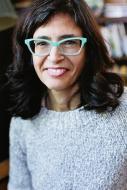
Julia Mickenberg
Associate Professor of American Studies at University of Texas at Austin
When did you first develop an interest in Slavic, East European and Eurasian Studies?
I became interested in Russia at a very young age, like many who grew up during the Cold War (I graduated from college in 1990). Russia had for me a kind of forbidden mystique. My grandfather took my sister and me to the Russian circus when we were children; and I also recall my grandparents visiting the Soviet Union in the mid-1970s, bringing our family a balalaika and matrushka dolls for my sister and me. I remember trying to pry the smallest one open, feeling like there was some important secret to be revealed in that tiny, unyielding wooden doll. In high school an especially open-minded history teacher had us read The Communist Manifesto, and my AP English teacher assigned Gogol, Dostoevsky, and Chekhov. It seemed natural that I would take Russian history and literature in college and study Russian, but my initial inclination to major in Russian Studies was dampened by my difficulty in learning the language (French had come so easily to me) as well as a Russian literature class that was less than inspiring. Plus, too many other things that caught my attention. I gave up Russian after the second year and majored in American Civilization.
How have your interests changed since then?
I went on to get a Ph.D. in American Studies, and became an American Studies professor, starting my current job at UT in 2001. My first book was on Children’s Literature and the Left. Studying the American communist milieu, however, inevitably raised the specter of the Soviet Union, which I began to see as the elephant in the room in many scholarly accounts of the American Left. My second single-authored book, American Girls in Red Russia: Chasing the Soviet Dream, explores the fascination with Russia and the Soviet Union among US women, many of whom traveled to the USSR in the 1920s and 1930s to see a society being born anew–especially one that promised to transform women’s lives. Work on this project brought me back to the Russian language classroom, where I once again struggled, this time as a tenured professor among much younger and seemingly much smarter undergraduates. However, I wasn’t getting graded, and this time I persisted and managed to learn enough to do research in a number of Moscow archives (a considerable feat). Although the book took me more than ten years to complete, I’m proud to say it was published this past spring by the University of Chicago Press.
What is your current research/work project?
I’m currently finishing an edited edition of the American feminist Madeleine Z. Doty’s account of the Bolshevik Revolution, which is contained in her 1919 book Behind the Battle Lines but has never been published on its own. I am currently writing an introduction and footnoting the relevant chapters, doing so as part of a series that Ben Whisenhunt and Norman Saul are editing for Slavica Press on “Americans in Revolutionary Russia.”
What do you value about your ASEEES membership?
I like being exposed to interdisciplinary scholarship on Russia and Eastern Europe, and being able to forge connections with scholars whose work is exciting and innovative. Despite my own home in American Studies I always find articles that interest me in The Slavic Review and I’ve really enjoyed panels at the ASEEES conventions I’ve been able to attend.
Besides your professional work, what other interests and/or hobbies do you enjoy?
Serving as Interim Director of the Center for Russian, East European, and Eurasian Studies (CREEES) and Acting Chair of the Department of Slavic and Eurasian Studies at UT Austin (filling in for Mary Neuburger, who is a real Slavicist). Although I feel like “acting” is the operative word, I’ve nonetheless had some successes in this role. Under my leadership CREEES recently won a Fulbright Hayes Group Projects Abroad grant to send twenty students and educators to Irkutsk, Siberia for instance. I’ve really enjoyed immersing myself in all things Slavic–it’s been a welcome change, and hopefully Mary won’t find the program in shambles when she returns to her post in January. When I’m not performing my role as chair/director, teaching, doing scholarship, or otherwise being a professor, I enjoy spending time with my daughters (11 and 14), reading fiction, doing yoga, running, and taking photographs.
